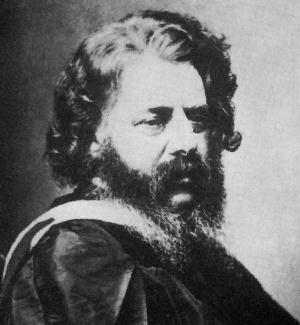William John Maquorn Rankine
(1820 - 1872)

Used with permission from the Institution of Civil Engineers, London
| World Wide Web of Geotechnical Engineers - Hall of Fame |
William John Maquorn Rankine
(1820 - 1872)

Used with permission from the Institution of Civil Engineers, London
The Man
One can only wonder if the brilliance of William John Maquorn Rankine was hereditary or if he was merely a prodigy of his time. In a lecture delivered before the British Geotechnical Society at the University of Glasgow on December 13, 1972, Hugh B. Sutherland, Cormack Professor of Civil Engineering from the University of Glasgow said of him:‘Rankine was no ordinary man.’
He humbly described his task of telling of Rankine’s life and times by saying:‘It has left me with the feeling that anything I can say is a tribute to a giant of the past from a tiny mortal of the present."
On ending his lecture, he stated:‘Rankine was the most wonderful combination of the man of genius and of humor. How much more pleasant and effective is the contribution, scientific or otherwise, when you know behind it lies a man capable of having a twinkle in his eye.’
William John Maquorn Rankine is a name engraved in scientific annals throughout the world. Rankine is best known for his accomplishments in thermodynamics (description of the operational cycle of an ideal engine using steam or another vapor) and soil mechanics (earth pressure theory). Yet another stellar attribute of this great man was his pioneering role as an engineering educator. He was born in Edinburgh, Scotland, on July 5, 1820. His learning consisted of a primary education taught mostly by his father and private tutors, and two extraordinary years of schooling at the University of Edinburgh. Leaving without a degree, Rankine set out to become a civil engineer. He apprenticed under Sir John Benjamin MacNeill, a notable civil engineer of his time who had been Thomas Telford’s chief assistant. He practiced the civil engineering profession until the late 1840’s, switching without hesitation to practice mathematical physics. From 1848 to 1855, Rankine spent a great amount of his time in researches on theoretical physics, thermodynamics and applied mechanics. On December 3, 1855, at the age of 35, Rankine was appointed by the Queen’s Commission to the Chair of Civil Engineering and Mechanics at Glasgow - a Regius Chair established by royal decree. His ensuing years, leading up to the time of his death, were spent as a professor and author. Rankine imparted an immense knowledge of learned theory and practice to eager students. Authoring 111 papers and writing numerous textbooks, his respective scientific findings remain a foundation in soil mechanics and thermodynamics today.
Civil Engineer
Very little is known today of Rankine’s work as a practicing civil engineer. However, it is apparent he was introduced during his second year of college to the profession by his father, David Rankine. The elder Mr. Rankine, a civil engineer, was a superintendent for the Edinburgh and Dalkeith Railway. Young Rankine spent a year assisting his father and then he left for Ireland, where he worked on railroad, hydraulic, and various other projects. After four years in Ireland, he returned to Scotland and worked with railway companies and consultants until about 1848.
Educator
"Pioneer with a determination" best describes William John Maquorn Rankine as an educator. Separate from his great contribution as an author, Rankine introduced and vigorously sought at Glasgow, a degreed program in engineering. Engineering courses in Rankine’s time were not recognized in fulfilling any degree requirements. Rankine first pushed for an award of Diploma in Engineering Science, but was turned down by Scotland University Commissioners. On a second effort, Rankine endeavored for the award and got approval. Lastly to Rankine’s effort were his success at establishing a BSc in science. Once again, Rankine’s incessant efforts aside from his respected knowledge gained him praise throughout the world for pioneering the engineering education.
Author
In his teaching, Rankine taught from practice and theory. His writing was no different. Rankine authored a very successful collection of engineering textbooks. Through his books, he was able to deliver systematic instruction in engineering. Some of his more renowned texts are A Manual of Applied Mechanics, A Manual of the Steam Engine and Other Prime Movers, A Manual of Civil Engineering, and A Manual of Machinery and Millwork. Without textbooks, some of Rankine’s great works may have gone unknown--this learned from other noted historians who have studied and documented his life. On the lighter side Rankine wrote the nontechnical books, Songs and Fables, A Memoir of John Elder, and Engineer and Shipbuilder.
References
H. B. Sutherland. Rankine: His Life and Times. Lecture delivered before the British Geotechnical Society at the University of Glasgow on 13 December 1972 to mark the centenary of the death on 24 December 1872 of William John Macquorn Rankine. London: 1973. "Rankine, William John Macquorn." Dictionary of Scientific Biography. 1975 ed., Vol. XI, pp. 291-295. "Rankine, William John Macquorn." Cambridge Biographical Dictionary. 1990 ed., pp.1216-1217. "Rankine, William John Macquorn." Encyclopedia Americana. 1996 ed., Vol. 23, p. 253. "Rankine, William John Macquorn." New Encyclopedia Britannica. 1997 ed., Vol. 9, p. 939.